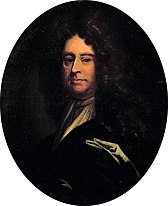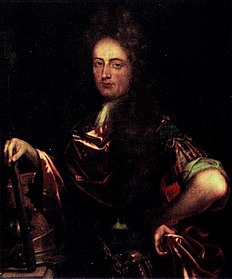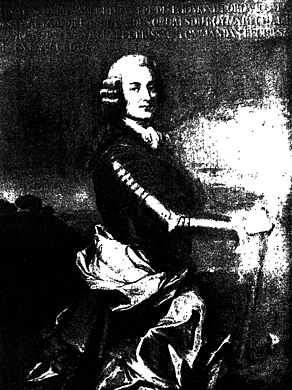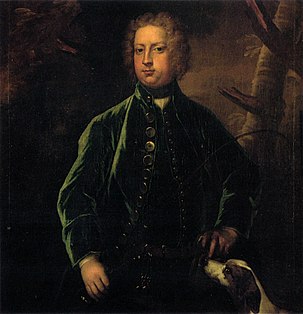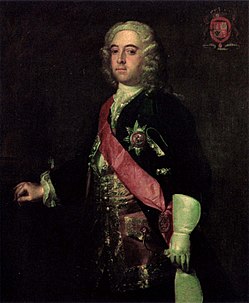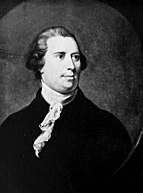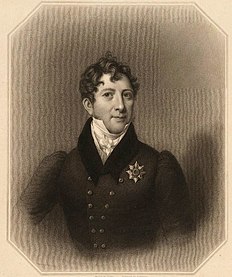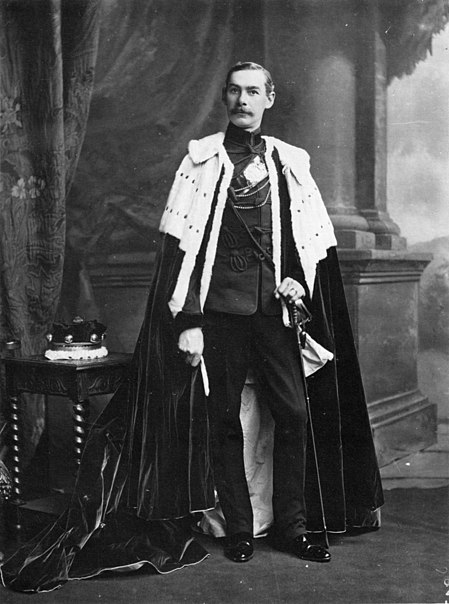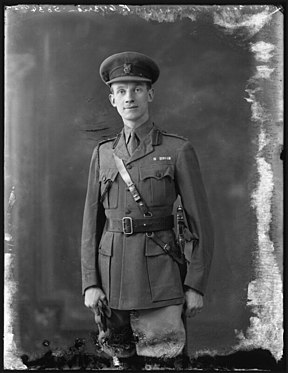Dalcassians
| Dalcassians | |||
|---|---|---|---|
| Dál gCais | |||
Déisi Tuisceart | |||
| Ethnicity | Gaelic Irish | ||
| Founder | Cas | ||
| Chief | |||
| Conor John Anthony, 19th Baron Inchiquin | |||
| Historic seat | Dromoland Castle | ||
| |||
| |||
| |||
The Dalcassians (
From the 12th–16th centuries, the Dál gCais contented themselves with being reduced to the
It wasn't until the 16th century, unable to be defeated militarily, that they agreed to surrender and regrant their kingdom to
History
Origins, Déisi Muman vs. Deirgtine
In their own genealogies, the Dál gCais traced their line back to their eponymous ancestor and progenitor Cormac Cas, who is said to have lived in the 2nd to 3rd century. They make him a second son of

It is claimed by current scholarship that the Dál gCais were instead a branch of the
The Déisi Muman themselves are the subject of
Ascent to the High Kingship of Ireland
The adoption of the name Dál gCais and the ascent of the group to greater power began to take place during the 10th century with internal political transition.
Kennedy's children built on their father's achievements. His daughter Órlaith became Queen consort of Ireland, after she married
A campaign in 977-78 led to the defeat and death of Ivar, with an engagement at
After the death of Brian, his two established surviving sons;
Dynastic divisions
Septs and kindreds
The septs of the Dál gCais developed over time, with new ones breaking off to form separate surnames at different times, but all claiming to share the same paternal line (with a few biological exceptions along the way due to adoption or extra-marital issue). Their eponymous founder Cas had several sons; two of them gave their names to the Uí Bloid and Uí Caisin kindreds, and another founded the Ui Fearmaic. As the proto-Dál gCais moved up into what is today
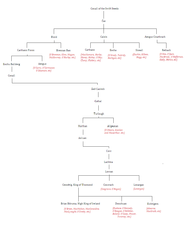


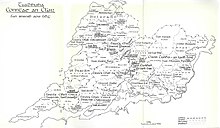
The senior line descended from Cas' first son Bloid and they provided the
Although a junior line, the Uí Caisin continued to have a prominent role and the leader of their kindred in Thomond were the
[21][22]Titles and social roles
Within the traditional
The most powerful Dalcassian family of the
The Clancy sept was the hereditary
Chieftainship
What became known as the Dál gCais stemmed from the Deisi Becc (Small Deisi) who controlled a narrow strip of land stretching from the Ballyhoura mountains to the Shannon and were divided into the Deisi Deiscirt (Southern Deisi, centred around Bruree) and Deisi Tuaiscirt (Northern Deisi, centred around Cahernarry) who shared a common ancestry.
In 934 the annals report the death of Reabacán mac Mothla who is described as King of the Dál gCais (the earliest extant usage of this dynastic name) and Abbot of Tuaim Gréine and in the same year his son was killed by one of the sons of Lorcáin mac Lachtna (who is said to succeed Rebeacán as king), the annals report "Duibhghiolla, son of Robacáin, Lord of Ua Corbmaic, was murdered by Congalach son of Lorcáin in treachery". This action must have paved the way for Lorcán and his sons to seize power.
The Dál gCais under Brian's descendants, the
In 1543
This early list of Dál gCais Kings is supplied in An Leabhar Muimhneach.[32]
Key:
 = King of Northern Deisi
= King of Northern Deisi- King of Thomond
 = Baron Inchiquin
= Baron Inchiquin = Viscount Clare
= Viscount Clare- Earl of Inchiquin
- Marquess of Thomond
A higher Kingship title which is mutually inclusive with a lower one within the dynasty are not given overlapping dates for the simplicity of the chart.
| List of Kings (and later heads) of the Dál gCais | |||||||||||||||||||||||||||||||||||||||||||||||||||||||||||||||||||||||||||||||||||||||||||||||||||||||||||||||||||||||||||||||||||||||||||||||||||||||||||||||||||||||||||||||||||||||||||||||||||||||||||||||||||||||||||||||||||||||||||||||||||||||||||||||||||||||||||||||||||||||||||||||||||||||||||||||||||||||||||||||||||||||||||||||||||||||||||||||||||||||||||||||||||||||||||||||||||||||||||||||||||||||||||||||||||||||||||||||||||||||||||||||||||||||||||||||||||||||||||||||||||||||||||||||||||||||||||||||||||||||||||||||||||||||||||||||||||||||||||||||||||||||||||||||||||||||||||||||||||||||||||||||||||||||||||||||||||||||||||||||||||||||||||||||||||||||||||||||||||||||||||||||||||||||||||||||||||||||||||||||||||||||||||||||||||||||||||||||||||||||||||||||||||||||||||||||||||||||||||||||||||||||||||||||||||||||||||||||||||||||||||||||||||||||||||||||||||||||||||||||||||||||||||||||||||||||||||||||||||||||||||||||||||||||||||||||||||||||||||||||||||||||||||||||||||||||||||||||||||||||
|---|---|---|---|---|---|---|---|---|---|---|---|---|---|---|---|---|---|---|---|---|---|---|---|---|---|---|---|---|---|---|---|---|---|---|---|---|---|---|---|---|---|---|---|---|---|---|---|---|---|---|---|---|---|---|---|---|---|---|---|---|---|---|---|---|---|---|---|---|---|---|---|---|---|---|---|---|---|---|---|---|---|---|---|---|---|---|---|---|---|---|---|---|---|---|---|---|---|---|---|---|---|---|---|---|---|---|---|---|---|---|---|---|---|---|---|---|---|---|---|---|---|---|---|---|---|---|---|---|---|---|---|---|---|---|---|---|---|---|---|---|---|---|---|---|---|---|---|---|---|---|---|---|---|---|---|---|---|---|---|---|---|---|---|---|---|---|---|---|---|---|---|---|---|---|---|---|---|---|---|---|---|---|---|---|---|---|---|---|---|---|---|---|---|---|---|---|---|---|---|---|---|---|---|---|---|---|---|---|---|---|---|---|---|---|---|---|---|---|---|---|---|---|---|---|---|---|---|---|---|---|---|---|---|---|---|---|---|---|---|---|---|---|---|---|---|---|---|---|---|---|---|---|---|---|---|---|---|---|---|---|---|---|---|---|---|---|---|---|---|---|---|---|---|---|---|---|---|---|---|---|---|---|---|---|---|---|---|---|---|---|---|---|---|---|---|---|---|---|---|---|---|---|---|---|---|---|---|---|---|---|---|---|---|---|---|---|---|---|---|---|---|---|---|---|---|---|---|---|---|---|---|---|---|---|---|---|---|---|---|---|---|---|---|---|---|---|---|---|---|---|---|---|---|---|---|---|---|---|---|---|---|---|---|---|---|---|---|---|---|---|---|---|---|---|---|---|---|---|---|---|---|---|---|---|---|---|---|---|---|---|---|---|---|---|---|---|---|---|---|---|---|---|---|---|---|---|---|---|---|---|---|---|---|---|---|---|---|---|---|---|---|---|---|---|---|---|---|---|---|---|---|---|---|---|---|---|---|---|---|---|---|---|---|---|---|---|---|---|---|---|---|---|---|---|---|---|---|---|---|---|---|---|---|---|---|---|---|---|---|---|---|---|---|---|---|---|---|---|---|---|---|---|---|---|---|---|---|---|---|---|---|---|---|---|---|---|---|---|---|---|---|---|---|---|---|---|---|---|---|---|---|---|---|---|---|---|---|---|---|---|---|---|---|---|---|---|---|---|---|---|---|---|---|---|---|---|---|---|---|---|---|---|---|---|---|---|---|---|---|---|---|---|---|---|---|---|---|---|---|---|---|---|---|---|---|---|---|---|---|---|---|---|---|---|---|---|---|---|---|---|---|---|---|---|---|---|---|---|---|---|---|---|---|---|---|---|---|---|---|---|---|---|---|---|---|---|---|---|---|---|---|---|---|---|---|---|---|---|---|---|---|---|---|---|---|---|---|---|---|---|---|---|---|---|---|---|---|---|---|---|---|---|---|---|---|---|---|---|---|---|---|---|---|---|---|---|---|---|---|---|---|---|---|---|---|---|---|---|---|---|---|---|---|---|---|---|---|---|---|---|---|---|---|---|---|---|---|---|---|---|---|---|---|---|---|---|---|---|---|---|---|---|---|---|---|---|---|---|---|---|---|---|---|---|---|---|---|---|---|---|---|---|---|---|---|---|---|---|---|---|---|---|---|---|---|---|---|---|---|---|---|---|---|---|---|---|---|---|---|---|---|---|---|---|---|---|---|---|---|---|---|---|---|---|---|---|---|---|---|---|---|---|---|---|---|---|---|---|---|---|---|---|---|---|---|---|---|---|---|---|---|---|---|---|---|---|---|---|---|---|---|---|---|---|---|---|---|---|---|---|---|---|---|---|---|---|---|---|---|---|---|---|---|---|---|---|---|---|---|---|---|---|---|---|---|---|---|---|---|---|---|---|---|---|---|---|---|---|---|---|---|---|---|---|---|---|---|---|---|---|---|---|---|---|---|---|---|---|---|---|---|---|---|---|---|---|---|---|---|---|---|---|---|---|---|---|---|---|---|---|---|---|---|---|---|---|---|---|---|---|---|---|---|---|---|---|---|---|---|---|---|---|---|---|---|---|---|---|---|---|---|---|---|---|---|---|---|---|---|---|---|---|---|---|---|---|---|---|---|---|---|---|---|---|---|---|---|---|---|---|---|---|---|---|---|---|---|---|---|---|---|---|---|---|---|---|---|---|---|---|---|---|---|---|---|---|---|---|---|---|---|---|---|---|---|---|---|---|---|---|---|---|---|---|---|---|---|---|---|
| |||||||||||||||||||||||||||||||||||||||||||||||||||||||||||||||||||||||||||||||||||||||||||||||||||||||||||||||||||||||||||||||||||||||||||||||||||||||||||||||||||||||||||||||||||||||||||||||||||||||||||||||||||||||||||||||||||||||||||||||||||||||||||||||||||||||||||||||||||||||||||||||||||||||||||||||||||||||||||||||||||||||||||||||||||||||||||||||||||||||||||||||||||||||||||||||||||||||||||||||||||||||||||||||||||||||||||||||||||||||||||||||||||||||||||||||||||||||||||||||||||||||||||||||||||||||||||||||||||||||||||||||||||||||||||||||||||||||||||||||||||||||||||||||||||||||||||||||||||||||||||||||||||||||||||||||||||||||||||||||||||||||||||||||||||||||||||||||||||||||||||||||||||||||||||||||||||||||||||||||||||||||||||||||||||||||||||||||||||||||||||||||||||||||||||||||||||||||||||||||||||||||||||||||||||||||||||||||||||||||||||||||||||||||||||||||||||||||||||||||||||||||||||||||||||||||||||||||||||||||||||||||||||||||||||||||||||||||||||||||||||||||||||||||||||||||||||||||||||||||
Annalistic references
- AI1021.2 Mael Muire Ua Gébennaig, eminent priest of Dál Cais, rested.
Legacy
In two different election pamphlets, Éamon de Valera's Fianna Fáil party addressed voters as "Dalcassians", the term having become a romantic synecdoche for the Irish as a whole.[33]
See also
- Irish nobility
- Irish royal families
- Pre-Norman invasion Irish Celtic kinship groups, from whom many of the modern Irish surnames came from
Notes
- Basilica di Santo Stefano al Monte Celio. The stories about his time there are recorded by Geoffrey Keating in the 17th century, some with skepticism. The story was used in the 19th century as a potential explanation for Laudabiliter.
- ^ Most information about the relationship between septs and their genealogical root can be found in John O'Hart's Irish pedigrees; or, The origin and stem of the Irish nation, where he worked from 17th-century genealogists Cú Choigcríche Ó Cléirigh and Dubhaltach Mac Fhirbhisigh, as well as the Annals of the Four Masters.
- ^ Said to be king on the arrival of Saint Patrick. Ancestor of both the Uí Óengussa and Uí Thoirdhealbhach branches. Purportedly baptized by Saint Patrick at Saingeal (Singland), Limerick (as per The Tripartite Life of Patrick, page 207, https://archive.org/details/TheTripartiteLifeOfPatrickV1/page/n415/mode/2up).
- ^ Involved in Battle of Carn Feradaig (629). See An Leabhar Muimhneach page 92-94 (linked in references).
- ^ According to another version of his genealogy he was the son of Díomasaigh, son of Rónáin (An Leabhar Muimhneach, page 319).
- ^ Geographical epithet indicates he may have been the first of Brian's line to settle around Craglea (Killaloe) and so likely a contemporary of Díoma mac Rónáin and a participant in the initial settlement. Ancestor of Uí Floinn and Uí Toirdhealbhach.
- ^ One of the eight Munster Kings whose names are recorded as guarantors of the Cáin Adomnáin and is described as rí in Déissi túaiscirt. https://archive.org/details/CainAdamnain/page/n31/mode/2up
- ^ Reabacán mac Mothla is the only king listed for whom no precise pedigree survives. He is included in a list of kings said to be descended from Óengus (see page 316 An Leabhar Muimhneach which is linked in references) and is therefore determined to be of the Uí Óengussa kindred but little else is known on his background. On his 934 death, he is noted in the annals as being both King of the Dal gCais (the earliest extant usage of this dynastic name) and Abbot of Tuaim Gréine. His purported pre-decessor Cormac must have died c. 850AD at the latest as his father Domhnall succeeded Torpaid upon his death in 765. This indicates several generations of Uí Oengusso dynasts for whom the records are lost for.
- ^ Deduced from:
• The An Leabhar Muimhneach king list which states that Lorcáin succeeded Reabachán Mac Mothla.
• The death date of Reabachán Mac Mothla being 934 (as stated in annals).
• The death date of Lorcáin as given in O'Harts Pedigrees (942 AD). - ^ Via special remainder from his uncle.
References
Footnotes
- ^ "Coat of Arms". The O'Brien Clan. 8 March 2011. Archived from the original on 3 March 2012.
- ^ a b The Tribe of Cas (26 August 2011). "Pedigree of MacMahon, Lords of Corca Baisgin, County Clare". Archived from the original on 21 November 2010. Retrieved 29 May 2012.
- ^ a b Family History Ireland (26 August 2011). "Marshal MacMahon and the Ottomans". Archived from the original on 21 December 2012. Retrieved 29 May 2012.
- ^ Family Steps by Leanne Chilver (29 May 2012). "Kennedy Origins Story".
- ^ Clan O'Reagan (29 May 2012). "Reagan Presidential Memorial".
- ^ a b Koch 2006, p. 554.
- ^ a b c d Duffy 2004, p. 121.
- ^ Davies 1994, p. 52.
- ^ ISBN 0899503624.
- ^ Rynne 1967, p. 230.
- ^ "Dál gCais or The Dalcassians of Thomond". DalcassianSept.com. 12 November 2008. Archived from the original on 8 September 2010.
- ^ a b c "Irish Pedigrees, O'Brien". DalcassianSept.com. 12 November 2008. Archived from the original on 19 September 2010.
- ^ "A Set of Distinctive Marker Values Defines a Y-STR Signature for Gaelic Dalcassian Families". JOGG.info. 7 July 2011. Archived from the original on 24 August 2012. Retrieved 13 July 2012.
- ^ "The Kingdom of Thomond". Clan MaConmara. 7 July 2012. Archived from the original on 15 October 2013. Retrieved 16 July 2012.
- ^ "Irish Pedigrees, MacNamara". DalcassianSept.com. 12 November 2008. Archived from the original on 19 September 2010.
- ^ "Irish Pedigrees, O'Grady". DalcassianSept.com. 12 November 2008. Archived from the original on 19 September 2010.
- ^ "Irish Pedigrees, Durkin". DalcassianSept.com. 12 November 2008. Archived from the original on 19 September 2010.
- Brian Ó Cuiv. 12 November 2008. Archived from the originalon 10 February 2012.
- ^ "Ui Fearmaic - Irish Names and Surnames". Archived from the original on 24 January 2020. Retrieved 13 February 2020.
- ^ a b "Irish Pedigrees, Quin". DalcassianSept.com. 12 November 2008. Archived from the original on 19 September 2010.
- ISBN 978-0940134980.
- ^ "VII. Kineal Fearmaic". Archived from the original on 20 November 2017. Retrieved 12 June 2019.
- ^ "The Dalcassian Knights, Gaelic Social Structure by Patrick M. O'Shea". DalcassianSept.com. 23 July 2012. Archived from the original on 30 October 2012. Retrieved 22 July 2012.
- ^ a b James Frost (26 August 2011). "The History and Topography of the County of Clare, Part I. Topography of Thomond Chapter 7. Corcomroe". Archived from the original on 20 September 2012. Retrieved 25 July 2012.
- ^ James Frost (26 August 2011). "The History and Topography of the County of Clare, Part I. Topography of Thomond Chapter 9. Ui Fearmaic; Gleann Omra; Ui Bracain; Ui Floinn; Ui Ronghaile". Archived from the original on 1 January 2013. Retrieved 26 July 2012.
- ^ County Clare Library (26 August 2011). "MacBrody, MacBruaideadha". Archived from the original on 31 December 2012. Retrieved 26 July 2012.
- ^ Moody 1991, p. 519.
- ^ History of the Dalcassians, Rev. John Ryan, https://dalcassiandna.com/NMAJ%20vol%2003%20no%204%2011%20The%20Dalcassians,%20by%20Rev.%20John%20Ryan.pdf
- ^ Bart Jaski, The (legendary) rise of Dál Cais', in: Seán Duffy (ed.), Medieval Dublin XVI: proceedings of Clontarf 1014–2014: national conference marking the millennium of the Battle of Clontarf (Dublin, 2017). 15–61., https://www.academia.edu/38265900/Bart_Jaski_The_legendary_rise_of_D%C3%A1l_Cais_in_Se%C3%A1n_Duffy_ed._Medieval_Dublin_XVI_proceedings_of_Clontarf_1014_2014_national_conference_marking_the_millennium_of_the_Battle_of_Clontarf_Dublin_2017_._15_61?source=swp_share Archived 19 July 2020 at the Wayback Machine
- ^ Brian Boru and the Battle of Clontarf, Seán Duffy, 2013, page 74
- ^ The Normans in Thomond, Joe Power http://www.clarelibrary.ie/eolas/coclare/history/norman.htm Archived 25 January 2019 at the Wayback Machine
- ^ Tadhg Ó Donnchadha,"An Leabhar Muimhneach", 1900, page 86, page 321-324, page 316, page 92-94, https://archive.org/details/leabharmuimhneac01odon/page/86/mode/2up, https://archive.org/details/leabharmuimhneac01odon/page/322, https://archive.org/details/leabharmuimhneac01odon/page/316, https://archive.org/details/leabharmuimhneac01odon/page/92/mode/2up
- from the original on 13 October 2019. Retrieved 2 January 2020.
Bibliography
- Davies, John (1994), A History of Wales, ISBN 0-14-014581-8
- Duffy, Seán (2004), Medieval Ireland: An Encyclopedia, ISBN 0-415-94052-4
- Koch, John (2006), Celtic Culture: A Historical Encyclopedia, ISBN 1-85109-440-7
- Moody, Theodore William (1991), Early Modern Ireland: 1534–1691, Oxford University Press, ISBN 0198202423
- Rynne, Etienne (1967), North Munster Studies: Essays in Commemoration of Monsignor Michael Moloney, Thomond Archaeological Society
- Byrne, Francis John, Irish Kings and High-Kings. Four Courts Press. 2nd edition, 2001.
- MacLysaght, Edward, Irish Families: Their Names, Arms and Origins. Irish Academic Press. 4th edition, 1998.
- O'Brien, Barry, Munster at War. Cork: Mercier Press. 1971.
- O'Brien, Michael A., ed. (1962). Corpus Genealogiarum Hiberniae. Vol. 1. Kelleher, John V. (intro. in the reprints of 1976 and 2005). Dublin: OCLC 56540733. Genealogies for the Dál Cais of Thomond
- Todd, James Henthorn (ed. and tr.), Cogadh Gaedhel re Gallaibh: The War of the Gaedhil with the Gaill Archived 11 May 2016 at the Wayback Machine Longmans. 1867.
- "Dál gCais – Church and Dynasty", Donncha Ó Corráin,
External links
- Tribes and Territories of Northern Munster: Dál gCais
- The Tribe of Cas at DalcassianSept.com
- Irish Type III at IrishType3DNA.org
- R-L226 Project at Family Tree DNA







